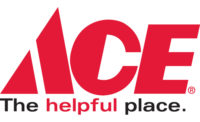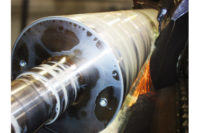Jeff Opad
Owner/CEO
Jemmco, LLC
14.5 years with the company
(262) 512-9559
www.jemmco.com
Matt Menges
President
Menges Roller Co.
Over 25 years with the company
(847) 487-8877
www.mengesroller.com
Bill Mikolenko
Sales Engineer
Empire Rollers and Coatings
10 years with the company
(585) 924-2020
www.empirerollersandcoatings.com
Cal Couillard
President and Design Engineer
Componex
16 years with the company
(608) 884-2201
www.componex.net
Q: What kinds of products do you offer to the flexible packaging market? (Anilox rolls, treater rolls, idler rollers, nip rollers, etc.?)
Opad: Jemmco offers a wide range of sleeve-style roller coverings employed in the making of flexible packaging. These include JemmTrom silicone treater sleeves, JemmTrac traction sleeves, JemmTac web-cleaning sleeves, JemmSil high-release sleeves and our newest, JemmStat conductive sleeves. Jemmco also offers a full line of live and dead shaft idler rolls, including our EZ sleeve rollers.
Menges: Menges offers, designs and manufactures just about every type of roller involved in the flexible packaging industry. We manufacture the complete roller core and can then cover rollers in rubber, silicone or any of our many synthetic compounds. Our specialty is double-shelled, spiral-baffle heat transfer rolls (‘chill rolls’), which are usually chrome-plated – and we’ve won several awards for our chill roll designs and products. Nip rollers, idler rollers, corona treater rollers, along with hot and cold rollers, are all part of our regular product mix for the flexible packaging industry. We do not manufacture bowed rollers or anilox rollers.
Mikolenko: We take a consultative approach when recommending roller solutions to flexible packaging markets. We look to solve problems by manufacturing rollers to improve operational efficiency and substrate quality. We apply unique coatings, such as Glassteel, Ceramics and PTFE, that are designed to achieve excellent release properties, increase dielectric strength, extend roller life and improve corrosion resistance. We offer many specialty rollers including Glassteel corona treater rolls, heating and cooling rolls, MDO rolls and nip and idler rolls.
Q: Which is your most widely used roller option for blown flexible film?
Opad: Jemmco offers two sleeves that are predominantly used by blown-film manufacturers. These are our wool fabric sleeves and our JemmTrac traction sleeves, which are often used on blown-film bubble cages and collapsing frames. Companies running films such as EVA’s will consider our JemmSil RS100 high-release sleeve for non-stick purposes. Blown-film companies often use our JemmTron corona treater coverings.
Mikolenko: Our Glassteel treater roll is widely recognized as the most durable and best-performing corona treater roll on the market. The Glassteel coating improves the quality and uniformity of the corona discharge while using less energy and creating less ozone than other corona treater rolls. Since Glassteel is a fused coating and not plasma sprayed, it creates a durable, non-stick surface that is cut-resistant and easily maintained.
Menges: Although we handle many of the OEMs (original equipment manufacturers) in the blown-film equipment manufacturing market and manufacture rollers for the entire process, our tower nip rollers, spreader rollers, nip and idler rollers are widely used. Our tower nip rollers are installed at the top of the blown-film tower, and work to compress the two halves of the film circle together. Our wrinkle removing ‘web spreader’ rollers are installed at various points throughout the line. Menges chill rolls are widely used in the production of cast film.
Couillard: Componex WInertia AV idlers work exceptionally well for blow-film lines such as cage rollers, which are typically smooth or brush rollers. The WInertia AV’s unique design allows the bubble to spin the roller with very little to no wrap angle. The land-gap-land design creates a very small corner that grabs the web and keeps the roller in motion, eliminating scratches on the newly formed plastic film.
Componex designed a very lightweight extrusion for this specific application. Our 2.25-by-2 AV tubing matches up with our 1-inch, low-friction, self-adjusting bearing. This bearing technology allows for shaft misalignment up to two degrees and will compensate linearly for thermal expansion. Unlike radial bearings that will gain in friction as loads and heat are applied, the WINertia self-adjusting bearings stay free spinning
Q: Which is your most widely used roller option for the coating and laminating of flexible film?
Mikolenko: We supply a PTFE-coated laminating roller that has a very smooth and uniform surface. This roller provides excellent release and good wear resistance. The uniformity of the roller surface allows for a consistent application of coating and laminating materials without imparting any surface imperfections onto the substrate. Our Glassteel corona treater roll is also used in this process to increase the surface energy of flexible films that will be coated or laminated.
Opad: JemmTac web-cleaning sleeves have proven to be an economical alternative for these markets, saving users as much as 90 percent of the cost of traditional web-cleaning roller coverings. Our JemmSil release coverings are an effective and economical alternative to high-release hard coats.
Couillard: Componex offers a variety of surface finishes, but when a smooth, wrinkle-free web is required, as is for coating and laminating, nothing beats the simple and effective WINertia AV with a reverse crown. The lateral grooves of the WINertia AV grip the web and ensure traction through eliminating air entrainment. They also ensure the web lies flat. Traditional spiral grooves allow thin films to dip into the grooves, which can cause troughing of the web — these are not fully formed wrinkles, but can be the start. The unique design of the WINertia AV avoids this problem. Componex then machines a reverse crown into the surface of the roller creating a profile that is smaller in the center than on the roll ends. There can be anywhere from .005 to .060 inches diameter difference between the center and the roll ends. The difference in diameter is based on web width and amount of deflection under load. Componex can help you determine the correct amount of reverse crown needed for your application. When a web travels over a roller with a reverse-crown profile, the edges of the web climb to the larger diameter. This creates a pulling effect from the center outward removing wrinkles and baggy areas of the web. We recommend a wrap of at least 60 degrees for best results.
Menges: Coating rollers require a very smooth and uniform finish on the roll cover, to ensure even application. Our silicone rubber roll covers are very popular for this process, but Hypalon, EPDM and anti-static roll covers are also widely used.
Laminating multiple layers of film often involves a heat-transfer roller, as the heat helps bond and cure the adhesive. This hot roller, which is almost always chrome-plated steel, is often used in a nipping function with a rubber roller pressing down from the top. This configuration can generate very nice laminating results. If the rubber roll is exceptionally long (for wide webs), the rubber may be given a slight parabolic crown.
Q: Which is your most widely used roller option used during the printing of flexible film?
Couillard: The most widely used roller for the printing of flexible films is our WINertia AV with our high-release WINtrac 2 coating. This combination helps solve two problems with printing on plastic films. Plastic films are very slippery and run at low web tensions that can cause the web to lose traction with the idler. This leads to film and ink scratching, loss of print registration and smearing of the ink. The lateral groove patterns in the AV roller allow air to escape, which keeps the web in traction. Combining the AV with our high release WINtrac 2 coating solves the issue of ink picking and smearing. This coating is very durable and even dried on inks can be cleaned off with soap and water. This combination offers a one-two punch when it comes to solving printing problems on plastic film.
Opad: JemmTac web-cleaning sleeves are also our most widely used option during the printing of flexible film.
Mikolenko: We recently developed a Glassteel fountain pan and ink-transfer rollers as an alternative to chrome-plated or aluminum fountain and ink-transfer rolls. The Glassteel fountain pan rollers are designed for use in the dampening systems of offset printers. The Glassteel coating applied to the roll surface has been formulated to substantially improve roller life and corrosion resistance.
Menges: We see many sleeve-style rollers for these processes, along with spreader rollers. However, as you know, in order for film to be printed, it must first be corona treated – and we offer several options for corona treater rolls. We manufacture them from scratch, but we also regularly recover these rolls, primarily in hypalon, EPDM or EP silicone.
Q: Does your company offer any roll-handling products? How does this help to protect the film on the web from damage?
Menges: We don’t offer “handling products” for rolls or spools. However, Menges does offer several ancillary products, all of which directly affect the roller and its performance. We offer a nip impression paper that allows engineers to measure the pressure of their nip systems, thus allowing for corrective pressure settings and proper specifying of crown dimensions. Menges also offers padded protective covers for high-value rollers (chrome-plated chill rolls and the like). And – to optimize the outcome of heat-transfer roll installations – Menges also partners with manufacturers of rotary unions, thermal fluids and chilling/heating units.
Q: Does your company offer a repair or replacement program for rolls/rollers?
Opad: All Jemmco sleeved roller products are designed for easy in-plant installation by customer employees to reduce downtime and eliminate the need for spare rollers and two-way shipping.
Mikolenko: We offer repair, replacement and resurfacing services on all rollers, whether manufactured by us or another supplier. We have a full-service machining operation, including surface preparation and restoration, grinding, polishing, turning and balancing capabilities.
Menges: Of course, all of our rollers are warranted. And we rarely have issues with breakage, especially with our utilization of strength-testing software for high-load rollers. But we regularly receive rollers manufactured by other companies that have broken journals and damaged cores. Menges Roller has a large in-house repair facility; we manufacture and install exact-fit replacement components. Repairs represent a large segment of our overall business.
Roll replacement is also a large segment of our monthly sales volume. With a robust fabrication facility, we manufacture replacement rollers up to 33 feet long. We work from customer-provided schematics or simply reverse engineer the old roller. Our technicians can also make any needed design tweaks, eliminating problems operators may have had with the original design. And then we provide any required chrome plating, rubber covers, groove patterns, balancing services and the like – all for a fraction of the price of going back to the OEM.
Q: What new products are you coming out with in 2015?
Mikolenko: We have developed a Glassteel dip roller that allows the roller coating to be coated “over the edge” of the roller surface. This improves corrosion resistance and protects the flanges from damage. This roller is used in tough environments where immunity from cleaning chemicals, ozone or high web tension is important.
Opad: Jemmco is introducing a new line of electrically conductive roller coverings. Our JemmStat CRS 100 conductive sleeves provide a soft rubber surface that won’t scratch or mar films and reduces static buildup on moving webs. The JemmStat CHS 100 is a high-temperature heat shrink sleeve that features excellent chemical resistance, solvent resistance, wear resistance and electrical conductivity.
Menges: At Menges, we expanded our capacity for manufacturing chill rolls in 2013 with the purchase of a large machine. And just recently, spring of 2014, we expanded our capabilities for rubber covered rollers with the purchase of a machine that brought our capacity up to 10 meters (33 feet). So expansion and modification is always important. For 2015 I think we’ll probably be looking at continued investment in technology. We’ve done well with our thermal-modeling services – which use computational fluid dynamics and other high-end computer technologies – to design heat-transfer rollers. And we’d like to make further use of technologies that automate the transition from design to production. Expansion is important, but so is optimizing and augmenting.
Q: What solid troubleshooting tips can you offer to readers?
Opad: In many applications, the use of roller coverings is an effective way to eliminate the need for spare rollers and two-way shipping, increase roll cover turnaround time and save money.
Mikolenko: Often roller damage is a symptom and not always an indication that your roller is designed or manufactured incorrectly. For instance, an unusual wear pattern on the roller surface may not be caused by a bad coating, but could be an indication of a misaligned nip roller, improper tension or even a winding problem. While changing a coating may help to improve wear resistance and performance, in the long run the real problem has not been solved. Our best advice is to ensure you have properly defined your problem before making unnecessary changes. If additional help is needed, call on people that have expertise in rollers and coatings.
Menges: This isn’t so much troubleshooting, but more so, a few preventive tips that can reduce roller wear.
The first thing is in the design: if you have rollers that will see heavy pressure or weight loads – as some nip rollers have – we recommend that customers always use a solid stress analysis or finite element analysis (FEA) application to test the load bearing capacity of the roller. And if you’re having a chill roller or heat-transfer roller made, definitely have a CFD model drawn up that details exactly how hot or cold the roller will get. Not to be too commercial, but Menges offers both FEA and CFD modeling services. We’ve heard so many stories of engineers that order rollers with certain specifications and dimensions; they put the roll in the machine and the journal breaks because it’s not strong enough, or the heat-transfer roll doesn’t get hot enough. By spending a few extra dollars on the proper computer modeling, a lot of this waste can be avoided.
Another important thing is acid flushing: this is for liquid filled chill and heat-transfer rolls. So many plants just let their rollers run and run without ever flushing the system or cleaning the residue from the roller’s internal cavity. Then, all of the sudden, they notice the roller doesn’t heat or cool like it should. One key to preventing this is having the roller acid flushed once a year. This is a chemical wash that breaks down residue, gunk and oxidized particles, and then flushes them from the roller. It keeps your thermal-transfer rates where you want them, and extends the life of the roller. It’s like getting an oil change in your car: it can be an inconvenience, but the machine will last longer.






